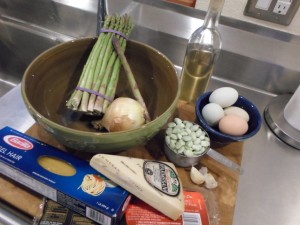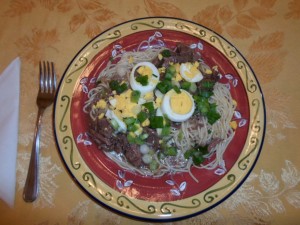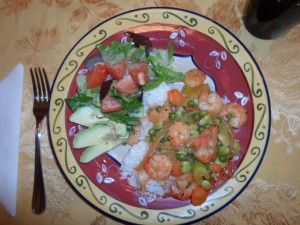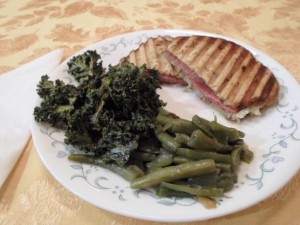Last Saturday morning while walking the beagle pup, I stopped by my asparagus patch hoping for new green shoots. I saw one with another just barely poking up its head. Yes! I love asparagus. I picked the one long green shoot, and since it was just one – the first – I ate it while I walked to the greenhouse to check on seedlings planted a couple of weeks ago. That asparagus shoot tasted so green, fresh and well…like spring! Oh, my goodness, I was inspired.
On Sunday while shopping for groceries, I purchased a bundle of asparagus. Those are good, but not as good as the ones grown in my own garden. However, with anticipation of more to come, I made pasta carbonara with asparagus, bacon and lima beans. It is a rustic Italian dish and wonderfully tasty.
Pasta Carbonara with Asparagus, Bacon and Lima Beans
1⁄2 lb. bacon, cooked and diced
1 Tbsp. olive oil (optional)
1 onion, chopped
1 cup lima beans, thawed
2 cloves garlic, minced
1 cup white wine
1 cup chicken stock
1 bunch asparagus, 1-inch sliced
4 ea. fresh eggs
1⁄4 cup parsley, minced
1 cup Parmesan cheese
1 lb. pasta, cooked and drained
Salt and freshly cracked black pepper, to taste
Preheat oven to 275 degrees. Place a large oven-proof serving bowl in the oven to warm.
Boil water in a large pot and cook pasta. Heat a large saucepan over medium-high heat and cook the bacon until crisp. Remove bacon and reserve. I usually cook the onions in the bacon grease, but for a healthier option discard the grease and use olive oil. Cook the onions until tender and then add lima beans and garlic and continue to cook for a few minutes more.
Add wine and chicken stock, reduce heat to low and let simmer until lima beans are tender and liquid is reduced. Add asparagus and cooked bacon. Keep warm over very low heat. Taste and add salt and pepper if necessary Just before the pasta is done, pull the warm serving bowl from the oven. Whisk eggs, parsley and Parmesan cheese together in the bowl. Drain the pasta and add to the egg mixture. Toss well to combine. The hot noodles will cook the egg mixture making a creamy sauce. Add the bacon-vegetable mixture and toss again.
Serve immediately with additional Parmesan cheese.




